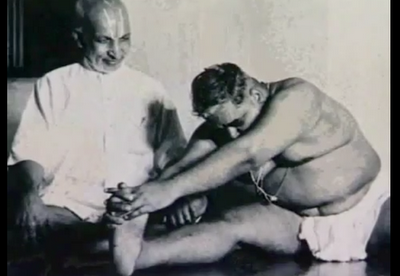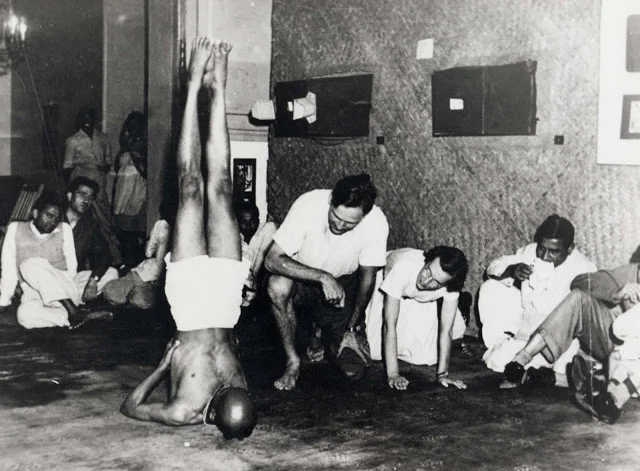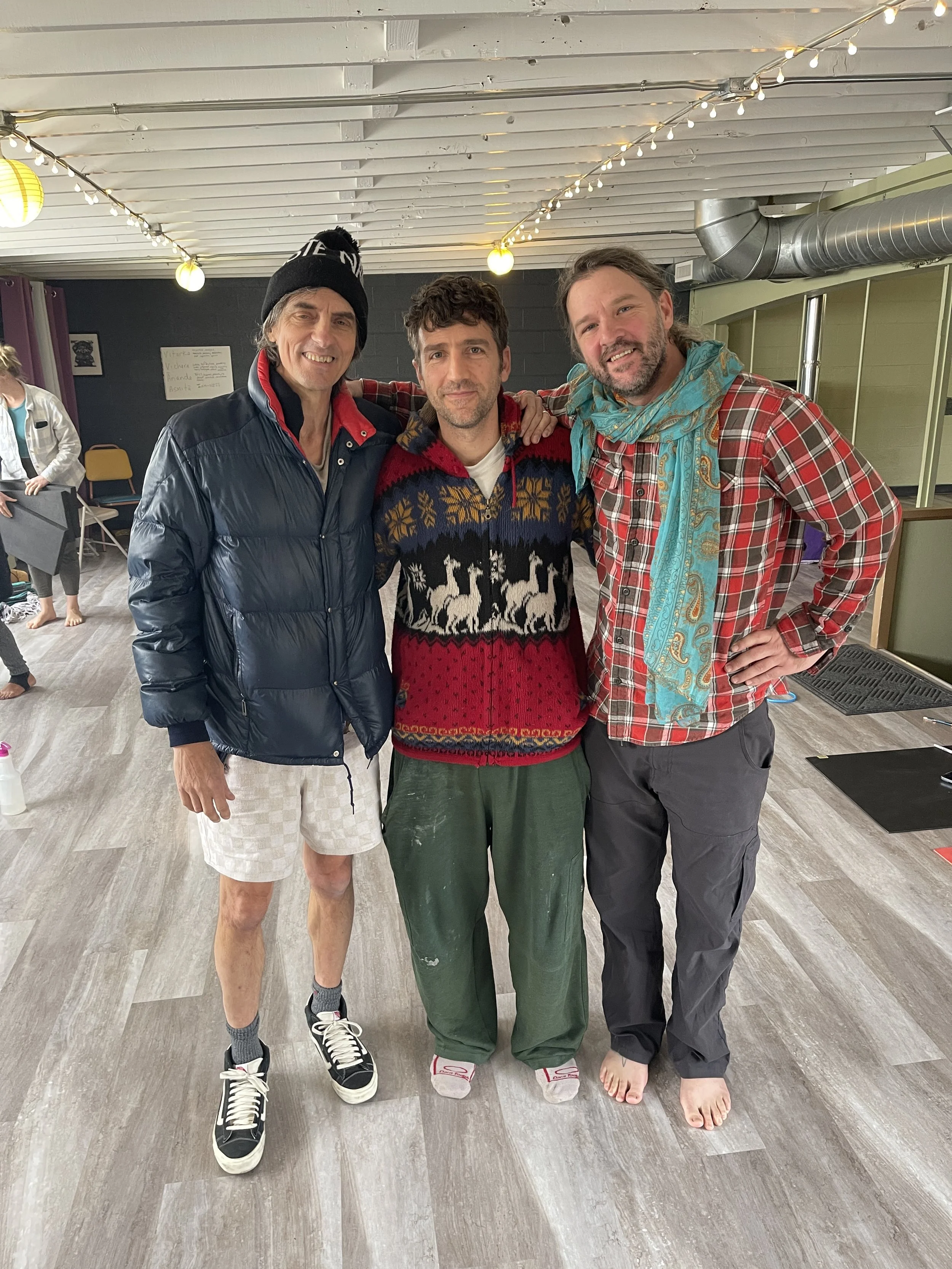The Story of how Traditional Ashtanga Yoga came to the Northwest USA
T. Krishnamacharya teaching the yoga posture Janu Sirsasana
Ashtanga Yoga is the format of yoga that has come to us from ancient times. It is described through the Yoga Sutras of Patanjali, and through other yoga shastras, and it is taught by some yoga teachers around the world. Ashtanga Yoga, as outlined in the yoga sutras (sutras 2:23-29), is a means of removing avidya (ignorance of the nature of dualistic reality), through an eight limbed method of practice in life. Ashtanga Yoga is a humanistic creation, spawning from the oldest philosophical system known to humanity, called Samkhya.
Studying yoga in the traditional way has never fit in well with mainstream societies, especially those that were less interested in personal development than economic development. In fact, most yogis throughout the past many centuries lived a life of asceticism, renouncing most worldly and material concerns. Ashtanga Yoga has always been a way of life for those willing to pursue its challenges, and to ride into the darkness of what lies within.
Because it was not accepted by the mainstream, and because its philosophy and many of its practitioners rejected the caste system, Ashtanga Yoga system existed in relative obscurity until the early 20th century when the last remaining master of yoga, Sri Ramamohana Brahmachari took pity on a young Brahmin named Tirumalai Krishnamacharya, and over the course of 7 years, taught him the secrets of yoga at the base of the Himalayas. Around the time of the first world war, the great teacher Brahmachari instructed his student, Krishnamacharya to give yoga to the world, as the people of the modern age to come was sick and needed healing. Brahmachari gave Krishnamacharya instructions on the location of a manuscript called “Yoga Korunta” which was a list of yoga asana groupings (yoga poses). The Korunta was a document that was written in palm leaves and was stored in a secret location. Krishnamacharya was charged with uncovering the Korunta, translating it, making it useable for modern people, and teaching it to the world. If it were not for this one order given and honored by a yoga teacher and a yoga student, it is likely that none of us would have yoga in our lives today.
When Krishnamacharya resurfaced in society after a 7 year period of dedicated study of yoga, he did locate the document called the Yoga Korunta that outlined sequences and forms of hatha yoga. Krishnamacharya spent a great deal of time documenting the practices of yoga that were in the Korunta, and eventually began teaching this very fast, very dynamic form of asana to the public. This style of yoga was documented in one of Krishnamacharya’s first books titled “Yogasanagalu”. The style that Krishnamacharya taught included transitional postures, as well as movements that correlated with specific breathing patterns (vinyasas), in addition to holding static “states” of postures (holding a pose for several breaths). This style of yoga is what is most commonly taught in “flow”, “vinyasa”, and “ashtanga” based classes today. Even what is called “hatha" yoga is often derived from Krishnamacharyas system. In fact, it has been observed that as much as 95% of yoga practiced today came directly from Krishnamacharya and the Korunta.
The original Korunta had 5 sequences or “groupings” of postures (this is often called a “krama” or a “set of postures in sequence”). Krishnamacharya changed it to 6 sequences by splitting the original 3rd sequence into two, so the original 3rd was to become what is now the 3rd and 4th series of Ashtanga. The Korunta included a copy of the Yoga Sutras of Patanjali, along with the yoga asanas. This document was a life guide for yogis, one half was how to practice asana and pranayama (the key components of hatha yoga), and the other was a manuscript on yoga philosophy.
Sri K Pattabhi Jois demonstrating salamba sarvangasana (shoulderstand)
Rebelling against the caste system, Krishnamacharya acted out of the norm for his brahmin caste and married a woman whom he loved, but was not arranged to be married. He traveled India, and honored the commission of his teacher, to give yoga to all people. It was during these travels that he happened to be called upon by the King of Mysore to teach him yoga, as he was very sick (Mysore is a large city in Southern India very famous for its role in yogas history). Eventually, this king would come to find great value in yoga, and constructed a yoga school in Mysore on the palace grounds. This legendary school still exists today as a landmark for modern day yoga. It is the legacy of this city, and the generosity of this king, which gave Ashtanga Yoga a solid footing by which it could be researched and refined over many decades.
It was one of Krishnamacharya’s early students, and a Sanskrit professor, Sri K Pattabhi Jois, who would eventually take over as leader of the type of yoga taught at the Royal Palace grounds in Mysore, India. In the 1950s, another of Krishnamacharya’s first students, Indra Devi, came to America and opened the first hatha yoga school in the US, in Los Angeles, where she taught celebrities and thus yoga gained in popularity. Also in the 1950s the first descriptive book on hatha yoga was published, called “Light on Yoga”, by BKS Iyengar, another of Krishnamacharya’s students. By the late 1960s and early 1970s, Americans and Europeans began seeking Jois out to learn the ancient form of Vinyasa Yoga, as it was originally taught in Mysore. From there comes the term “Mysore Style” or “Mysore Class”, as it is done in the style that was taught at the famous yoga shala of Sri K Pattabhi Jois. As an Indian man who was a Sanskrit scholar, Jois never learned English, and new very little of it when first asked by foreign travelers “what style of yoga is this that you teach”; Jois simply replied “Ashtanga”. As a result, even though Ashtanga is a philosophy of life outlined in the Yoga Sutras of Patanjali, the word “Ashtanga” became associated with the style of yoga that came from the Korunta, and with Jois himself. American marketing did not have time to distinguish between Jois and the rest of the tradition, and thus it became rumored the Pattabhi Jois had invented Ashtanga Yoga; this is not true, obviously, but Jois was the lineage holder of the style of yoga that originated from the Korunta, and up until his death, Pattabhi Jois taught the sequences of Ashtanga Vinyasa Yoga in a manner very similar to what his teacher, the great Krishnamacharya, taught to him.
BKS Iyengar (left) and Sri K Pattabhi Jois (right). Two of the most influential yoga students of T. Krishnamacharya.
By the 1990s the original Ashtanga Yoga system taught by Krishnamacharya and later by Pattabhi Jois in Mysore, had influenced the United States greatly. The awkwardly pronounced sanskrit word “Ashtanga” (meaning “8 limbs”) was then called “power yoga” originally by people in Southern California, who began opening large yoga studios in the model of the fitness industry. Over time, in the US, yoga lost its method of transmission from one teacher to one student, and took the format of the more profitable fitness industry. Jois, the contemporary master of Ashtanga Yoga (also known as “Ashtanga vinyasa” yoga) voiced displeasure with the way that American consumerism had turned the practice of yoga into a “circus”.
Notably, a meticulously adapted form of Ashtanga taught by BKS Iyengar, grew in popularity in the US at the same time. Even though both Jois and Iyengar were both students of Krishnamacharya, they learned a different method of yoga. It could be said that the biggest difference between these two styles of yoga (Iyengar and Ashtanga Vinyasa) is that Iyengar learned the same postures as Jois, but added to them improvisations, adaptations, props, and utilized a focus on alignment, while Jois never deviated from the simple method taught to him by Krishnamacharya. It could be said that the Iyengar system is also from the Korunta, as is evident from reading the book “Light on Yoga”; the postures are the same, they are simply practiced in a different manner.
As traditional Ashtanga Yoga started being taught in the United States, it became more and more commodified, and altered for consumption by the public. Much of its original aspects were removed, its more difficult or demanding postures (especially those which required patience to develop) taken out, its devotional practices, intense discipline, culturally distant (to Westerners) Sanskrit counting system did not fit in, so yoga teachers changed the sanskrit terms to trendy animal names (alligator pose anyone?). As more and more trendy styles of yoga were invented by Americans, they took pieces from the system of the Korunta without teaching its entirety. Yoga teachers were necessarily profiting from its vital energy giving systems, without maintaining its integrity. While these styles of yoga were giving great health benefits through the intrinsic power of hatha yoga practices, they certainly were not teaching yoga in the manner that it was designed.
Back in Mysore, Pattabhi Jois continued to teach the system of Ashtanga Yoga that was passed down to him by Krishnamacharya, in a largely unchanged way. Sri K Pattabhi Jois remained steadfast in teaching Ashtanga Yoga in its original format, up until his death in 2009. At that time, roughly 30 people around the world were certified from Jois to teach Ashtanga Yoga. All of these teachers were encouraged by Jois to continue the tradition of the postures in the Korunta, and to return to their homelands to teach. Thus, Ashtanga Vinyasa Yoga spread throughout the world.
David Garrigues hosting Pattabhi Jois and family in Seattle at Pike’s Place Market in 1999, when the legendary Ashtanga Yoga School of Seattle was created by two of his most dedicated students.
David and Luke in 2009
The people of the Pacific Northwest would be uniquely blessed with two certified Ashtanga Yoga teachers. One a local from Seattle, and another a woman from France. Both were dedicated students of Pattabhi Jois, and they started the Ashtanga Yoga School of Seattle. Shortly after its invention, Sri K Pattabhi Jois took a trip to Seattle to bless the efforts of two of his most devoted students, David Garrigues and Catherine Tisseront. This visit would ignite the fire of Ashtanga in the Pacific Northwest. For many years, Seattle was a gathering place for dedicated Ashtanga practitioners. The director of Ashtanga Yoga School of Bellingham/Yoga Spirals, Luke Baugh, was a student of the Ashtanga Yoga School of Seattle, under these two teachers, starting in 2005. At that time the website of the Ashtanga Yoga School of Seattle was www.yogaspirals.com.
Within recent years, our northwest Ashtanga Yoga community has went through many changes. The Ashtanga Yoga School of Seattle disbanded as Catherine Tisseront passed away in 2010. This was shortly after Luke finished his teacher training and started his own yoga school in his hometown of Lewiston, Idaho. Sri K Pattabhi Jois and BKS Iyengar, also passed away within a few years. The lack of leadership from these pillars of the Ashtanga Yoga lineage left the ancient teachings of Ashtanga Yoga even more vulnerable to the economic and commercially driven profiteers of the West. While yogic masters are now available at the touch of a button through the surge of internet based yoga instruction, and more and more new yoga teachers are coming into the fold having little to no connection to the original lineage that spawned this great and now global movement; something is missing. The local yoga school, where teachers and students gather to learn from each other, is perhaps more important now than ever to provide instruction and guidance for students who are overburdened with information and a lack of connection to the meaning of the practice. Our goal is to remain connected to the ancestry and traditions of Ashtanga Yoga through continual practice in our lineage, and support of the Ashtanga community in our region and globally, while also teaching asanas that are adapted to fit each individuals needs.
Luke Baugh in eka pada sirsasana, at his yoga school circa 2008
Today, over 90,000 registered yoga teachers exist in the USA, and nearly 700 registered yoga teachers are within 50 miles of Bellingham alone. Many yoga teachers call their practice “hatha”, “vinyasa”, “flow”, or “alignment” yoga; most all of these types of yoga are explorations into aspects of the systems of Ashtanga Yoga taught by Krishnamacharya, and a few others. When we go to a yoga class, meet a yoga teacher, or take an online course, perhaps we should ask them; “who is your teacher, and where did this style of yoga come from?”, and keep in mind that it is the tradition of yoga itself, a gift from the ancestral people of India, who instruct us to continue learning in an unbroken lineage, in the spirit of devotion to the practice, so that those to come after us may also benefit. Ask yourself if you believe it to be appropriate to change thousands of years of dedication, from people who served the lineage of yoga, giving their lives to the science so that we may benefit from it. Would it not be appropriate to honor them by learning their methods, learn from their experiences, their texts, and the practices they taught, which are still alive through the lineage today?
David and Luke (with Andrew) in 2022. Practicing together for nearly 20 years at time of this picture.
While there are certainly advantages to having greater access to yoga through internet and an increased number of teachers, there are some things that have been lost to our detriment, and one of them is the vital sanctity of a local yoga shala (school), which honors the traditions and formats of the system of yoga that has been given to the world after thousands of years of dedication and research from honorable ancestors of humanity. In todays yoga “industry”, it almost seems that the deep spiritual practice of yoga has been rebranded as an exotic form of exercise, or performance art. Those who seek to find the nectar within the scriptures and practice of yoga know that we must learn under the guidance of those that studied before us. Those who seek practice under the teachings of yoga will undoubtedly find the sweetness of yoga. Ashtanga Yoga School of Bellingham seeks to be a space for our community members who wish to undertake the practice of yoga in this light.
Notably, while we are a traditional yoga school by comparison to others, and our asana sequences are based on the vinyasa sequences of Sri K Pattabhi Jois, and the great T. Krishnamacharya, we hold a non-dogmatic view towards the progression of asana, and seek to advance our knowledge of it through playful and devoted experiential research. Ashtanga Yoga, which is the method of yoga practice outlined in the Yoga Sutras of Patanjali, and from which has come nearly all yoga practiced today, is accessible to all people.
Ashtanga Yoga School of Bellingham is here to provide a space for students and teachers of yoga to continually refine our understanding of asana, while we live in harmony with the principles of our practice, the teachings of our teachers, the traditions of lineage, and seek to honor those wise yogis that came before us, in India, to give us this practice. We seek to gain real knowledge (yoga sutra 1.7) through continual practice of the sequences and forms given to us by our lineage, and by relying on the wisdom of the ancient masters who wrote yoga shastras such as the Siva Samhita, Hatha Yoga Pradipika, Yoga Sutras, Samkhya Yoga Karika, and more. We realize that to seek understanding of yoga without guidance is vanity; thus, we humbly take practice daily in the spirit of devotion towards truth, with the bright light of tapas burning inside.
The great yogi T. Krishnamacharya
We are here to share our practice and understanding of the 8 limbs of yoga, and find platforms of understanding and community, where this understanding can take root, and develop within the hearts of practitioners who seek to gain the knowledge from continual, devoted practice (Yoga Sutra 1:14). The practice of Ashtanga Yoga has been often misunderstood, and practiced incorrectly by many people. We cannot do anything to remedy those misunderstandings, but for those that seek out the nectar of Ashtanga, we can provide a place of practice for you. Yoga of this method all came from one place, and for several generations, and has been passed from teacher to student, in an unbroken lineage called parampara. Please join us in participating in our devotional practice of Ashtanga Yoga, the practice of the 8 limbs, as outlined by the great sage Patanjali. You too can take practice!
Om.








